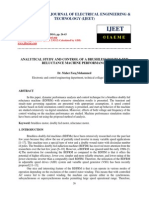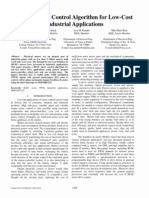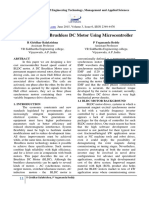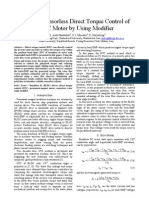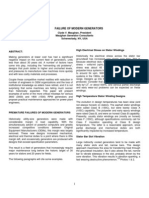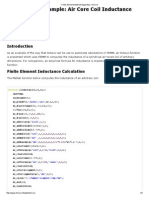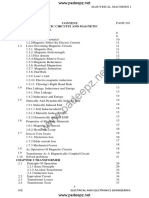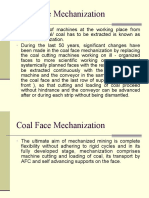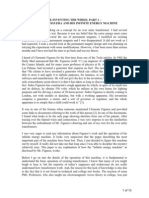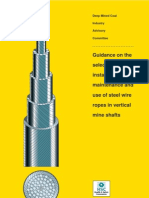8396 IEEE TRANSACTIONS ON POWER ELECTRONICS, VOL. 35, NO.
8, AUGUST 2020
Variable Speed Operation of Brushless Doubly Fed
Reluctance Machine Drive Using Model
Predictive Current Control Technique
Karuna Kiran , Student Member, IEEE, and Sukanta Das , Senior Member, IEEE
Abstract—To accomplish an accurate and fast drive control, θr Angular position (rad) of rotor.
model predictive control (MPC) is considered as an effective con- pp , ps , pr Primary, secondary, and rotor poles.
trol strategy nowadays. In MPC, the voltage vectors required for θp , θs Primary and secondary reference frame position
inverter control are evaluated considering the control objectives
defined in terms of current or power or torque and flux. The optimal (rad).
one is selected using an iterative prediction loop and applied in the Pp , Q p Primary active (W) and reactive (VAr) power.
next control interval. This form of MPC is simple in implementation k Discrete time index.
and shows appreciable dynamic performance but the steady-state
performance is compromised due to the limited availability of the Superscript
number of voltage vectors, especially in the case of a two-level r, s Rotating and stationary frame quantities.
voltage source inverter. The present article explores the viability ref Reference value of a variable.
of the MPC approach for a new candidate such as a brushless
doubly fed reluctance machine drive considering its secondary Subscript
current as the control variable. Moreover, to tackle the steady-state p, s Primary and secondary variables.
inferiority issue, the duty-cycle control concept is inducted. In d, q Direct and quadrature components of a variable.
comparison to field-oriented control (FOC), the proposed scheme a, b, c Phase quantities.
offers a straightforward solution for current control by replacing
the inner current proportional–integral controllers and pulsewidth
modulator with an optimization-based model predictive current
controller. An extensive simulation study in MATLAB, vis-à-vis I. INTRODUCTION
comparison with FOC scheme, and experimental validations justify
ECENT research works reveal that the brushless doubly
the claims of the proposed work.
Index Terms—Ac machines, brushless machines, current
R fed machines (BDFMs) have the potential to efficiently
substitute conventional slip ring induction machine (SRIM)
control, predictive control. and singly fed machines in variable-frequency speed control
of motor drives and variable-speed constant-frequency genera-
NOMENCLATURE
tion systems [1]. The possibility of using low-cost fractionally
Rp , Rs Primary and secondary winding resistances (Ω). rated inverter for limited speed range applications, improved
Lp , Ls , Lps Primary, secondary winding self and mutual in- reliability of brushless rotor [2], additional manifold modes of
ductances (H). operation, flexible control of active and reactive power, crow-
v, i, λ Voltage (V), current (A), and flux linkage (Wb-t) barless low-voltage ride-through grid integration capability, etc.,
vectors. are some distinct advantages to contest with the conventional
ωp , ωs Primary and secondary voltage/current angular choices [3].
frequency (rad/s). The family of BDFMs has two sets of electrically independent
ωr ,ωrm Nr Electrical, mechanical angular speed of rotor in three-phase stator windings sharing the common magnetic
(rad/s), and the number of revolution per minute circuit with the involvement of a rotor. The primary winding
(r/min). is connected directly to a constant three-phase ac supply at
power frequency. However, the secondary winding frequency
Manuscript received June 20, 2019; revised September 21, 2019 and Novem- is regulated through a bidirectional converter to achieve the
ber 17, 2019; accepted December 26, 2019. Date of publication January 5, 2020; desired speed [1]. In addition, both the windings have different
date of current version April 22, 2020. This work was supported by Science
and Engineering Research Board (Department of Science and Technology), pole configurations [4], [5]. Various types of BDFM topologies
GOI, under Young Scientist Scheme YSS/2015/001670. Recommended for with different rotor structures are extensively studied in recent
publication by Associate Editor H. Hofmann. (Corresponding author: Sukanta decades, such as cage rotor, reluctance rotor, wound rotor, and
Das.)
The authors are with the Department of Electrical Engineering, Indian Institute hybrid rotor. The characteristics of these rotor structures and
of Technology (Indian School of Mines), Dhanbad 826004, India (e-mail: some exemplary references are enlisted in [5]. The reluctance
karunakiran108@gmail.com; asksukanta@iitism.ac.in). and cage rotors are two major types of rotor structures used in
Color versions of one or more of the figures in this article are available online
at http://ieeexplore.ieee.org. BDFMs. The BDFM drive having a reluctance rotor is simple in
Digital Object Identifier 10.1109/TPEL.2020.2964007 modeling and control and more robust and reliable in off-shore
0885-8993 © 2020 IEEE. Personal use is permitted, but republication/redistribution requires IEEE permission.
See https://www.ieee.org/publications/rights/index.html for more information.
�7878 IEEE TRANSACTIONS ON POWER ELECTRONICS, VOL. 34, NO. 8, AUGUST 2019
Sensorless Speed Estimation of Brushless
Doubly-Fed Reluctance Generator Using
Active Power Based MRAS
Mukesh Kumar , Sukanta Das , Member, IEEE, and Karuna Kiran , Student Member, IEEE
Abstract—This paper proposes an active power based model ref- θ p , θs Angular positions of primary and secondary
erence adaptive system for sensorless speed estimation of primary reference frames (rad).
field oriented brushless doubly-fed reluctance generator (BDFRG). Te , TL Electromagnetic and mechanical load
In this regard, the active power associated with secondary winding torques (Nm).
of BDFRG is used for the process of speed estimation. BDFRG is Pm , Pp , Ps Shaft, primary, and secondary winding elec-
more reliable and requires less maintenance. Its structural advan-
tages demonstrate higher working efficiency and lower losses as
trical powers (W).
compared to equivalent doubly-fed induction machines. Moreover, Q Reactive power (VAR).
active power of BDFRG can be controlled by suitable speed regu- ˆ, ∗ Estimated, reference quantities.
lation, which in turn can be achieved by a low rating bidirectional ε, • Error signal, d/dt operator.
converter connected to the stator secondary (i.e., control) winding. Suffix ‘0’ Constant value.
These inherent features make BDFRG as a prospective candidate
in the applications like wind and tidal power generation. The effi- I. INTRODUCTION
cacy of the proposed control technique is established by a 1.6 kW
RUSHLESS doubly-fed reluctance generator (BDFRG)
BDFRG in MATLAB/Simulink. A dSPACE-1103 based laboratory
prototype is used for the hardware validation. B has come across as potential viable replacement over the
conventional doubly-fed induction generator (DFIG) for limited
Index Terms—Active power, doubly-fed, model reference adap- speed range applications like wind power generation [1]–[3].
tive system (MRAS), primary field orientation, reluctance machine. Despite belonging to the slip-power recovery group, the slip
rings and brushes are eliminated in BDFRGs thereby enhancing
NOMENCLATURE their reliability [4], reducing their maintenance requirements
pr , pp , ps Rotor, primary, and secondary winding pole considerably, increasing their operational efficiency, and making
numbers. them economically more sustainable in comparison to DFIGs
vp , vs Primary and secondary winding phase volt- [5]. Moreover, BDFRGs have the added advantages such as
ages (V). higher efficiency [6], [7], increased robustness, [8] and ease
vpd , vpq , vsd , vsq Primary and secondary dq-axis voltages (V). in controllability [2] over the traditional brushless doubly-fed
ipd , ipq , isd , isq Primary and secondary dq-axis currents (A). induction machines (BDFIMs). Furthermore, BDFRG shows
Rp , Rs Resistances of primary and secondary wind- stable operation at no load around synchronous speed, whereas
ings (Ω). BDFIM suffers from instability [7], [9].
Lp , Ls , Lps Self-, and mutual-inductances of primary A contemporary BDFRG is designed with two three-phase si-
and secondary windings (H). nusoidal distributed stator windings each having dissimilar pole
λp , λs , λps Primary, secondary, and mutual flux (Wb). numbers and operating frequencies. It consists of a reluctance
ω p , ωs Primary and secondary windings supply fre- type rotor wherein number of poles is numerically half the num-
quency (rad/s). ber of total stator poles [10]. This structure develops a magnetic
ωr , ωr m Rotor electrical and mechanical angular coupling depending upon the shaft position for the production
speeds (rad/s). of electromagnetic torque in the rotor. Moreover, the rotor wind-
ings are absent in the BDFRG structure. Non-existence of the
rotor windings leads to the increased machine efficiency owing
to a decrease in the rotor copper loss [11], [12]. The primary
Manuscript received July 3, 2018; revised October 7, 2018; accepted Novem- stator winding is fed directly from the grid, while the secondary
ber 12, 2018. Date of publication November 20, 2018; date of current version
May 22, 2019. This work was supported by the Science and Engineering Re- (i.e., control) winding is connected through a back-to-back con-
search Board (Department of Science and Technology), GOI under Young Sci- verter, which facilitates the bidirectional flow of power. The
entist Scheme (YSS/2015/001670). Recommended for publication by Associate converter capacity, in this regard, is almost 25% of the machine
Editor I. Slama-Belkhodja. (Corresponding author: Sukanta Das.) rating. This is capable in regulating the speed over a wide range
The authors are with the Department of Electrical Engineering, Indian
Institute of Technology (Indian School of Mines), Dhanbad 826004,
including super-synchronous to sub-synchronous speed by the
India (e-mail:,mukeshkumarbuntysingh@gmail.com; asksukanta@iitism.ac.in; variation of frequency and phase sequence of secondary voltage
karunakiran108@gmail.com). [11], [13].
Color versions of one or more of the figures in this paper are available online Various control methodologies of brushless doubly-fed reluc-
at http://ieeexplore.ieee.org. tance machine (BDFRM) have been reported in the literature.
Digital Object Identifier 10.1109/TPEL.2018.2882473
0885-8993 © 2018 IEEE. Personal use is permitted, but republication/redistribution requires IEEE permission.
See http://www.ieee.org/publications standards/publications/rights/index.html for more information.
�Electric Power Components and Systems, 46(6): 701–715, 2018
Copyright # Taylor & Francis Group, LLC
ISSN: 1532-5008 print / 1532-5016 online
DOI: 10.1080/15325008.2018.1466006
Sensorless Speed Control of Brushless Doubly-Fed
Reluctance Motor Drive using Secondary Flux
based MRAS
Karuna Kiran1 , Sukanta Das1 , Mukesh Kumar1, and Abhijit Sahu2
1
Department of Electrical Engineering, Indian Institute of Technology (Indian School of Mines), Dhanbad,
Jharkhand, India
2
School of Electrical and Computer Engineering, Purdue University, West Lafayette, Indiana, USA
CONTENTS
Abstract—Different MRAS based approaches are gaining ample
1. Introduction importance for the speed estimation of AC machine drives
because of their simplicity and direct physical interpretation. In
2. Primary Field Oriented Control Strategy of BDFRM
this work, MRAS is introduced for the sensorless control of
3. Formulation of Secondary Flux Based MRAS (SF-MRAS) promising low-cost brushless doubly-fed reluctance motor drive
4. Stability and Sensitivity Study of the Proposed Scheme under primary field orientation and maximum torque per inverter
5. Simulation Studies ampere (MTPIA) conditions. In this regard, secondary flux vectors
are employed as the control quantity in the formulation of the
6. Experimental Results proposed MRAS. All the analytical studies, in this context, are
7. Conclusion carried out in MATLAB=Simulink. The scheme is further
Funding validated by a real-time experimentation using dSPACE-1103
based brushless doubly-fed reluctance machine (BDFRM)
References prototype. The simulation study and test results confirm the robust
Appendix A performance of the proposed controller around the synchronous
speed. The investigation decisively affirms the feasibility of
MRAS based approach for sensorless speed control of BDFRM
drive as well.
1. INTRODUCTION
The brushless doubly-fed reluctance machines (BDFRMs)
are comparatively newer candidates in the doubly-fed
machine community and drawing more attention over the
traditional doubly-fed induction machines (DFIMs) because
of their lower constructional complexity, cost effectiveness,
robustness, increased reliability, improved efficiency, and
lower maintenance requirement [1], [2]. Alike brushless
doubly-fed induction machines (BDFIMs) [3], the stator of
BDFRM consists of two windings: primary and secondary
Keywords: AC drives, control technique, electric drive simulation, flux whereas unlike BDFIM, its rotor is cageless reluctance
estimation, motor controls, motor drives, space vector pulse width type having high-saliency-ratio and the number of rotor
modulation (SVPWM), state estimation, vector control
Received 16 November 2016; accepted 24 March 2018 poles is equal to the total number of stator pole pairs [4],
Address correspondence to Sukanta Das, Department of Electrical [5], [6], [7]. A detailed comparative study of BDFIM and
Engineering, Indian Institute of Technology (Indian School of Mines), BDFRM is available in [8]. The primary winding of
Dhanbad, Jharkhand-826004, India. E-mail: asksukanta@rediffmail.com
Color versions of one or more of the figures in the article can be found
BDFRM is directly supplied from the grid and the direc-
online at www.tandfonline.com=uemp. tion of power flow in this winding dictates the operating
701
�IET Power Electronics
Research Article
Implementation of reactive power-based ISSN 1755-4535
Received on 12th February 2017
Revised 18th August 2017
MRAS for sensorless speed control of Accepted on 7th September 2017
E-First on 13th November 2017
brushless doubly fed reluctance motor drive doi: 10.1049/iet-pel.2017.0104
www.ietdl.org
Karuna Kiran1, Sukanta Das1
1Department of Electrical Engineering, Indian Institute of Technology (Indian School of Mines), Dhanbad, India
E-mail: asksukanta@rediffmail.com
Abstract: The present work introduces the concept of classical reactive power (Q)-based model reference adaptive system
(MRAS) for the speed estimation and control of low-cost BDFR motor drive. The reasons behind such choice for this drive's
control are: (i) MRAS-based controllers can inherently take care of the machine parameter variations which had been a
challenging issue with the other available sensorless speed estimation strategies and (ii) the employment of Q as a functional
candidate inevitably makes the formulation immune to the variations in stator resistance. The experimental assessment, in this
respect, confirms these claims. Furthermore, the analytical validation of Popov's hyperstability criteria on the proposed
controller, confirms the drive's overall stability within the investigated speed control range. The speed control performance is
examined in MATLAB/Simulink. The simulation results are further validated by a real-time implementation using dSPACE-1103-
based 1.6 kW BDFR machine prototype.
Nomenclature A detailed comparative study between BDFIM and BDFRM is
available in [6].
ipd, ipq, isd, isq d–q primary and secondary currents (A) The stator of BDFRM consists of two electrically and
vpd, vpq, vsd, vsq d–q primary and secondary voltages (V) magnetically isolated three-phase windings: primary and
λpd, λpq, λsd, λsq d–q primary and secondary winding fluxes secondary. The electromagnetic (EM) torque production in the
(Wb) machine depends on the magnetic coupling between the windings
Rp, Rs primary and secondary winding resistances through a position-dependent highly salient cageless reluctance
(Ω) rotor with its number of poles equal to the total number of stator
Lp, Ls primary and secondary winding self- pole pairs [7, 8]. The primary winding of BDFRM is usually fed
inductances (H) from the grid, whereas the secondary winding is powered by a
λps, Lps mutual flux (Wb) and inductance (H) fractionally rated variable-voltage-variable-frequency converter for
T e, T l electromagnetic and load torque (Nm) bi-directional power flow between the grid and the machine under
pr, pp, ps number of rotor poles, primary and secondary subsynchronous, synchronous and supersynchronous speeds [3, 9,
pole pairs 10].
ωp, ωs primary and secondary supply angular Various methodologies such as scalar control [3, 11], vector or
frequencies (rad/s) field-oriented control (VC/FOC) [3, 9–12], direct torque (DTC)
ωr, ωrm rotor electrical and mechanical angular speed and secondary flux [11, 13] or primary reactive power [14, 15]
(rad/s). Herein after denoted as speed (rad/s) control, direct power control [16] and variable structure control [2]
σ = 1 − Lps2
/(LpLs) leakage factor have been addressed in the literature to achieve different control
ε error signal objectives of BDFRM-based drives. A comparative and
∙ time derivative operation progressive work with respect to these control strategies is also
θr, θp, θs rotor, primary and secondary reference frame available in [11, 12]. However, the execution of these closed-loop
positions controls relies on the rotor position/speed feedback. Moreover, a
limited number of research efforts are put forward for the
sensorless speed control of such drives [11–13, 17]. Except for a
Subscripts
very recent work based on sensorless FOC of BDFRM [12], the
A, B, C/a, b, c primary/secondary-phase quantities remaining works are primarily concerned with the DTC-based
strategies. In addition, model reference adaptive system (MRAS)-
Superscripts based control techniques have been overlooked yet for this
machine. The MRAS-based approaches are simple in formulation
r/s rotating and stationary reference frame quantity and implementation; and inherently take the machine parameter
*, ^ reference/command and estimated quantities variations into account with minimum computational effort [18].
Since, MRAS-based control techniques have been used
1 Introduction satisfactorily in the other AC drives, these techniques are also
resourceful for BDFRM drive as well. Depending on the functional
In recent years, brushless doubly fed reluctance machines candidate used for the formulation of the error, a number of
(BDFRMs) have shown better suitability for the applications such MRASs based on either rotor flux [19, 20] or back electromotive
as wind power generation [1, 2] and pump-type appliances [3, 4] to force [21] or reactive power [22–24] or active power or EM torque
meet narrow variable speed requirement. Greater robustness, [25] or V ∗ × I [26] are developed for induction machines (IMs). A
simple but efficient speed control strategies, lower capital detailed review of different MRAS-based controllers for IM drive
investment and maintenance cost than the other slip-power is presented in [27].
recovery machines [5] [such as BDF inductance machines Hence, the present work intends to introduce the MRAS-based
(BDFIMs)] are the major grounds behind their growing popularity. new approach for sensorless speed control of BDRFM (as motor)
IET Power Electron., 2018, Vol. 11 Iss. 1, pp. 192-201 192
© The Institution of Engineering and Technology 2017








